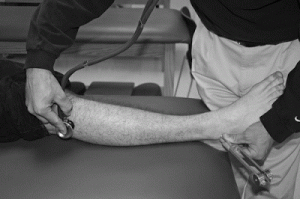Cheat #1: How to rule in/out a fracture.
Other than the important clinical signs like: traumatic injury, immediate swelling, inability to weightbear, severly limited range of motion.. how is a good way to rule in/out a possible fracture?
One of the items that I keep in my sports physio kit is a tuning fork – good ol’ 128Hz low C – and my stethescope.
A recent cross-sectional study looked at a way to detect a fracture non-radiographically (ie: no X-ray, and without the subjective input of the patient.
They assessed 37 patients that had possible fractures in long distal bones (eg: fibula). The stethescope was proximal to the suspected fracture site, and the tuning fork was struck and placed on the bone distal to the fracture site. This is obviously working on muscles that are closer to the skin surface – a femur would be pretty hard to assess.
Diminished (as compared to the non-affected limb) or absent sound conduction would demonstrate a positive test.
Sensitivity and specificity values displayed significant results at .83 and .80 respectively.
I do want to re-inforce that this should not be your only tool when confirming or discarding the diagnosis of a fracture. Radiographs are still a gold-standard for confirmation, but some may need a bone scan (depending on the bone). Some outcome measures can also be useful – such as the Ottawa Ankle and the Ottawa Knee Rules, both of which have solid research behind them.
You can check out the article (free) here: http://www.ncbi.nlm.nih.gov/pmc/articles/PMC2681212/


